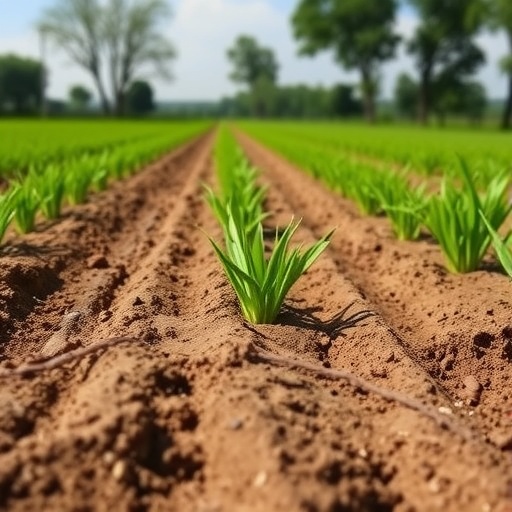In an era defined by rapid advancements in technology and a pressing need for sustainable agricultural practices, a recent study has shed light on the intricate relationship between soil characteristics, crop productivity, and the application of geospatial techniques. The research, conducted by a team of experts, including Saikia, Patgiri, and Deka, aims to map agro-potential by meticulously evaluating soil suitability and crop productivity in a scientific backdrop that intertwines environmental monitoring with agricultural optimization.
Soil health is an integral factor influencing crop yield and sustainability, yet traditional methods of assessing soil quality often fall short in their ability to provide comprehensive insights. This research harnesses the power of geospatial techniques, a series of methodologies that combine geography with data analysis, to evaluate and visualize agricultural landscapes. By utilizing tools such as Geographic Information Systems (GIS) and remote sensing, researchers can effectively discern patterns in soil composition and its capacity to support various crops over expansive areas.
The study focuses on the integration of soil data and crop productivity metrics to identify regions best suited for agricultural development. Traditional assessments often rely on a limited number of samples collected from discrete points, which can lead to skewed perceptions of overall soil health. In contrast, the use of geospatial techniques allows for a holistic examination of larger agricultural expanses, thus providing a more reliable framework for decision-making in land use and crop selection.
A critical aspect of this research lies in its methodological approach, which involves the collection and analysis of multiple soil parameters, including pH, organic matter content, nutrient levels, and texture. By triangulating this data with crop productivity statistics obtained from agricultural surveys, the researchers can construct a detailed profile of soil suitability for various crops. This approach not only enhances the precision of soil assessments but also facilitates the prediction of crop yield under different management practices.
Furthermore, the significance of this research extends beyond mere agricultural output; it is deeply entrenched in addressing the challenge of food security in an increasingly unpredictable world. As climate change and population growth exert unprecedented pressures on food systems, the need to optimize agricultural land becomes exceedingly urgent. This study contributes to the ongoing discourse on sustainable practices, encouraging farmers and policymakers to develop strategies rooted in scientifically-grounded assessments of soil health.
The findings of this research are anticipated to serve as a vital reference for stakeholders across the agricultural spectrum—from farmers to agronomists and policymakers. By delineating areas of high agro-potential, farmers can be guided in their land-use decisions, allowing them to maximize productivity while also minimizing environmental impact. This aspect is especially crucial as the global community seeks to balance the demands of increased food production with the need to conserve natural resources.
Moreover, the technological implications of the study are profound. The application of geospatial techniques underscores a shift towards data-driven agriculture, where decisions are increasingly based on empirical evidence rather than anecdotal experiences. As the agricultural sector embraces these innovations, the potential for improved crop management and soil conservation practices expands significantly.
In addition to practical applications, this research highlights the growing importance of interdisciplinary collaboration in addressing complex environmental issues. The integration of soil science, geography, and data analytics exemplifies how diverse fields can converge to create solutions to pressing challenges. Such collaborative efforts are essential to fostering a resilient agricultural sector capable of adapting to the myriad changes posed by our modern world.
As more researchers adopt similar methodologies, the agriculture industry may witness a paradigm shift towards more sustainable practices that prioritize both productivity and environmental health. The ongoing exploration of the synergies between technology and agriculture provides a blueprint for future research, spurring innovation in how we approach food production and land management.
With its comprehensive approach to soil analysis, this study showcases the potential for technological methodologies to revolutionize our understanding of agro-potential. By aligning scientific inquiry with practical applications, it serves not only as an academic contribution but as a clarion call to stakeholders in agriculture to embrace change and innovation.
The anticipation of how these findings will influence future agricultural policies and practices is palpable. As governments and institutions strive to enhance food security amidst evolving challenges, the insights gained from this research may very well inform crucial policy decisions aimed at fostering sustainable agricultural development.
In conclusion, the research conducted by Saikia and colleagues stands as a testament to the powerful synergy between geospatial technology, soil science, and agricultural productivity. It is a significant step forward in our quest for sustainable solutions to food production challenges, underscoring the vital role of innovative scientific techniques in shaping the future of agriculture.
Subject of Research: Soil suitability and crop productivity through geospatial techniques.
Article Title: Mapping agro-potential through evaluating soil suitability and crop productivity using geospatial techniques.
Article References:
Saikia, R., Patgiri, D.K., Deka, B. et al. Mapping agro-potential through evaluating soil suitability and crop productivity using geospatial techniques.
Environ Monit Assess 197, 1296 (2025). https://doi.org/10.1007/s10661-025-14748-2
Image Credits: AI Generated
DOI: https://doi.org/10.1007/s10661-025-14748-2
Keywords: Geospatial techniques, Soil suitability, Crop productivity, Sustainable agriculture, Food security.




